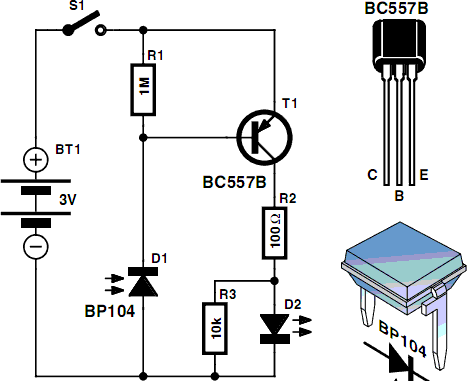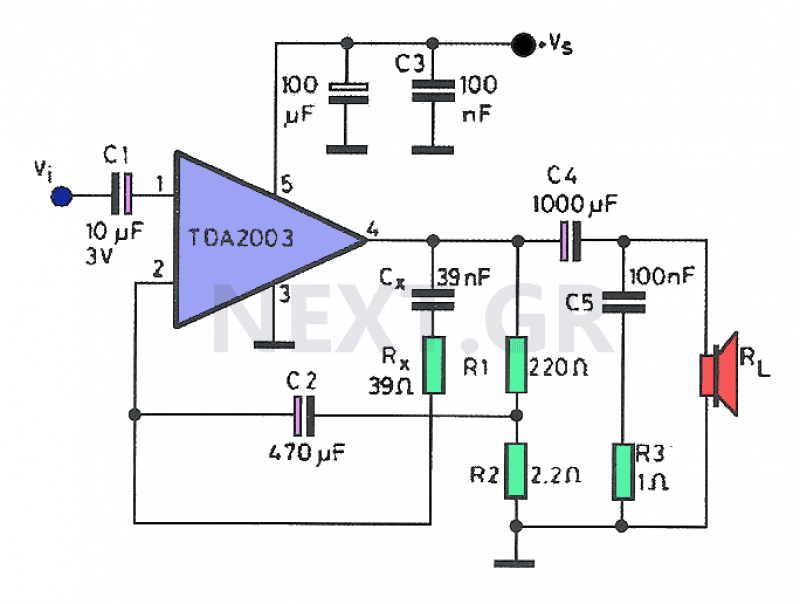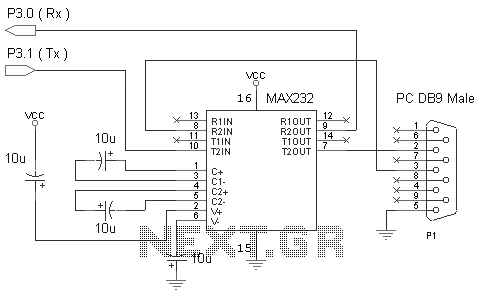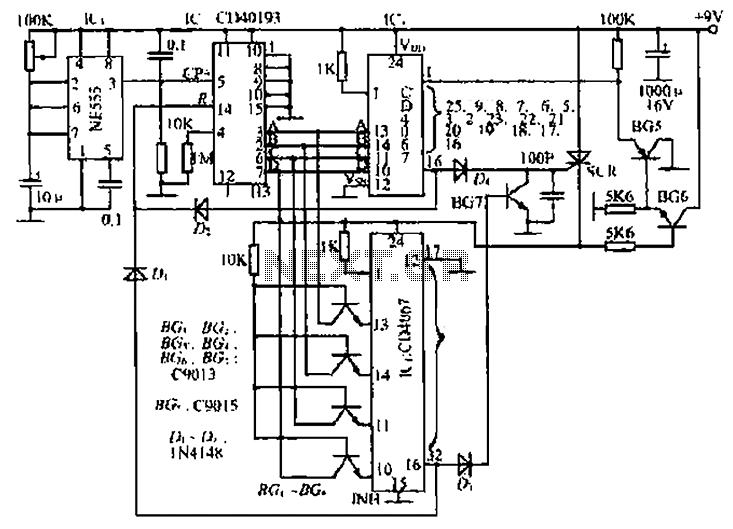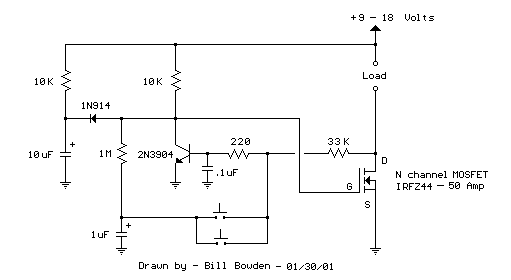
Motion Detector Circuit
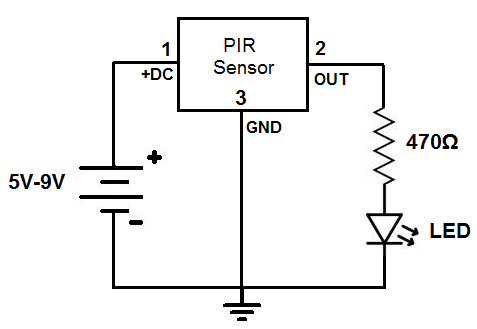
This circuit is designed to detect motion or movement, with its most common application being the detection of a person moving through an area covered by the motion detector. The primary electronic component utilized for this detection is the PIR (Passive Infrared) motion sensor, which detects movement by sensing infrared waves. Humans emit infrared waves, allowing the detector to respond according to the design of the circuit. The sensor can also detect the movement of inanimate objects, such as a rolling ball, as friction generates heat, which emits infrared radiation detectable by the PIR sensor if sufficient. The PIR motion sensor is capable of detecting movement by picking up infrared radiation emitted by warm bodies. The sensor can effectively detect people walking within a range of up to 20 feet (6 meters) and has a detection angle of 110 degrees vertically and 70 degrees horizontally. To evaluate its sensitivity, it is advisable to test movement across all angles to determine the effective detection range. The sensor's placement should be optimized based on these tests.
Pin 1 of the PIR module receives positive DC voltage, requiring between 5V and 9V for operation; 6V is typically used, which can be sourced from a regulated DC power supply or four AA batteries in series. This voltage is connected to pin 1 of the PIR module. Pin 2 serves as the output pin, where the PIR's output is transmitted. When motion is detected, the output voltage rises to approximately 3V; when no motion is detected, the output voltage drops to near zero. This output can be used to power a load, such as an LED, indicating motion detection. A 470-ohm resistor is connected in series with the LED at the output pin of the PIR sensor. When motion is detected, the output voltage increases, illuminating the LED. After a brief period of 1 to 2 seconds, the output returns to a low state, turning off the LED until motion is detected again. In order to create a motion detector alarm circuit, a silicon-controlled rectifier (SCR) and a buzzer can be added, which will continuously sound when the motion detector is triggered.
The PIR motion sensor operates on the principle of detecting changes in infrared radiation levels. This is achieved through two pyroelectric sensors that are positioned next to each other. When a warm object, such as a human body, moves across the sensor's field of view, it creates a differential signal between the two sensors, triggering the output. The detection range and sensitivity can be adjusted by changing the positioning of the sensor or by using lens attachments that modify the field of view.
For practical implementation, the circuit can be further enhanced by integrating a microcontroller for more complex behavior, such as timed delays, multiple outputs, or integration with other sensors. The output pin of the PIR can be connected to a microcontroller's digital input, allowing for programmable responses to detected motion. This integration can facilitate the development of advanced features such as automated lighting, security alerts, or notifications to a mobile device.
In summary, this motion detection circuit provides a versatile platform for various applications, from simple LED indicators to complex security systems, by leveraging the capabilities of the PIR motion sensor and additional electronic components. Proper testing and calibration of the sensor's placement and sensitivity are essential for optimal performance in real-world scenarios.This is a circuit which can detect any motion or movement. It`s most common use is to detect a person moving through an area where the motion detector can sense. The main electronic component we will use that allows us to pick up this detection is the PIR motion sensor.
The PIR motion sensor is a sensor which detects movement through picking up in frared waves. Being that a person emits infrared waves, the detector is able to detect these waves and react, according to the how the circuit is designed to react. The sensor can also pick up the movement of inanimate objects as well, such a rolling ball, because as those objects move, friction acts on them, generating heat.
This heat emits infrared radiation, which the PIR sensors may be able to detect if great enough. The PIR motion sensor is, again, a sensor which can detect movement through picking up infrared radiation. Being that people naturally give off radiation, because of our generated body heat, the motion can easily detect people walking and moving through a vicinity within the sensor`s range.
The motion sensor has a sensitivity range up to 20 feet (6 meters) and a 110G‚ ° x 70G‚ ° detection range, making it a wide lens detection sensor. This means it can measure 110G‚ ° vertically (from top to bottom) and 70G‚ ° horizontally (from left to right).
The best way to check its sensitivity is when the circuit is built, try moving around through all of its angles. See at which angles it can detect your movement and at which angles it is not able to detect your movement, meaning your out of its angle scope.
A lot of it is trial and error and experimenting. Once you know where it can and cannot detect, you can place it in an optimal place where it can detect in areas where you want it to. Pin 1 is the pin which receives the positive DC voltage. The PIR motion sensor needs between 5V-9VDC of power for operation. In our case, we will use about 6V of power. This can be obtained from switching a DC power supply to 6V or using 4 `AA` batteries connected in series.
We will then feed this voltage into pin 1 of the PIR module. Pin 2 is the Output pin of the PIR module. This is where the output of the PIR will leave from. When motion is detected by the PIR, its output will go high to 3V. When no motion is detected, its output low and it gives off practically no voltage. When high you can see then how it can power a load, such as an LED to light. This way we can know when it has detected motion or not. In our circuit, we will connect a 470G resistor in series with an LED to the output pin of the PIR sensor. When motion is detected, the output of the PIR sensor will swing high and power and light the LED. In this circuit, when motion is detected, the output voltage swings high and powers the LED. After about 1 second or 2, the output swings back low and the LED turns off until motion is detected again.
Without any motion, the LED just stays off. To build a motion detector alarm circuit, we add a SCR and a buzzer that continously buzzes when the motion detector is triggered. To find out how to build this slightly more advanced motion detector circuit, see how to build a motion detector alarm circuit.
🔗 External reference
Pin 1 of the PIR module receives positive DC voltage, requiring between 5V and 9V for operation; 6V is typically used, which can be sourced from a regulated DC power supply or four AA batteries in series. This voltage is connected to pin 1 of the PIR module. Pin 2 serves as the output pin, where the PIR's output is transmitted. When motion is detected, the output voltage rises to approximately 3V; when no motion is detected, the output voltage drops to near zero. This output can be used to power a load, such as an LED, indicating motion detection. A 470-ohm resistor is connected in series with the LED at the output pin of the PIR sensor. When motion is detected, the output voltage increases, illuminating the LED. After a brief period of 1 to 2 seconds, the output returns to a low state, turning off the LED until motion is detected again. In order to create a motion detector alarm circuit, a silicon-controlled rectifier (SCR) and a buzzer can be added, which will continuously sound when the motion detector is triggered.
The PIR motion sensor operates on the principle of detecting changes in infrared radiation levels. This is achieved through two pyroelectric sensors that are positioned next to each other. When a warm object, such as a human body, moves across the sensor's field of view, it creates a differential signal between the two sensors, triggering the output. The detection range and sensitivity can be adjusted by changing the positioning of the sensor or by using lens attachments that modify the field of view.
For practical implementation, the circuit can be further enhanced by integrating a microcontroller for more complex behavior, such as timed delays, multiple outputs, or integration with other sensors. The output pin of the PIR can be connected to a microcontroller's digital input, allowing for programmable responses to detected motion. This integration can facilitate the development of advanced features such as automated lighting, security alerts, or notifications to a mobile device.
In summary, this motion detection circuit provides a versatile platform for various applications, from simple LED indicators to complex security systems, by leveraging the capabilities of the PIR motion sensor and additional electronic components. Proper testing and calibration of the sensor's placement and sensitivity are essential for optimal performance in real-world scenarios.This is a circuit which can detect any motion or movement. It`s most common use is to detect a person moving through an area where the motion detector can sense. The main electronic component we will use that allows us to pick up this detection is the PIR motion sensor.
The PIR motion sensor is a sensor which detects movement through picking up in frared waves. Being that a person emits infrared waves, the detector is able to detect these waves and react, according to the how the circuit is designed to react. The sensor can also pick up the movement of inanimate objects as well, such a rolling ball, because as those objects move, friction acts on them, generating heat.
This heat emits infrared radiation, which the PIR sensors may be able to detect if great enough. The PIR motion sensor is, again, a sensor which can detect movement through picking up infrared radiation. Being that people naturally give off radiation, because of our generated body heat, the motion can easily detect people walking and moving through a vicinity within the sensor`s range.
The motion sensor has a sensitivity range up to 20 feet (6 meters) and a 110G‚ ° x 70G‚ ° detection range, making it a wide lens detection sensor. This means it can measure 110G‚ ° vertically (from top to bottom) and 70G‚ ° horizontally (from left to right).
The best way to check its sensitivity is when the circuit is built, try moving around through all of its angles. See at which angles it can detect your movement and at which angles it is not able to detect your movement, meaning your out of its angle scope.
A lot of it is trial and error and experimenting. Once you know where it can and cannot detect, you can place it in an optimal place where it can detect in areas where you want it to. Pin 1 is the pin which receives the positive DC voltage. The PIR motion sensor needs between 5V-9VDC of power for operation. In our case, we will use about 6V of power. This can be obtained from switching a DC power supply to 6V or using 4 `AA` batteries connected in series.
We will then feed this voltage into pin 1 of the PIR module. Pin 2 is the Output pin of the PIR module. This is where the output of the PIR will leave from. When motion is detected by the PIR, its output will go high to 3V. When no motion is detected, its output low and it gives off practically no voltage. When high you can see then how it can power a load, such as an LED to light. This way we can know when it has detected motion or not. In our circuit, we will connect a 470G resistor in series with an LED to the output pin of the PIR sensor. When motion is detected, the output of the PIR sensor will swing high and power and light the LED. In this circuit, when motion is detected, the output voltage swings high and powers the LED. After about 1 second or 2, the output swings back low and the LED turns off until motion is detected again.
Without any motion, the LED just stays off. To build a motion detector alarm circuit, we add a SCR and a buzzer that continously buzzes when the motion detector is triggered. To find out how to build this slightly more advanced motion detector circuit, see how to build a motion detector alarm circuit.
🔗 External reference

